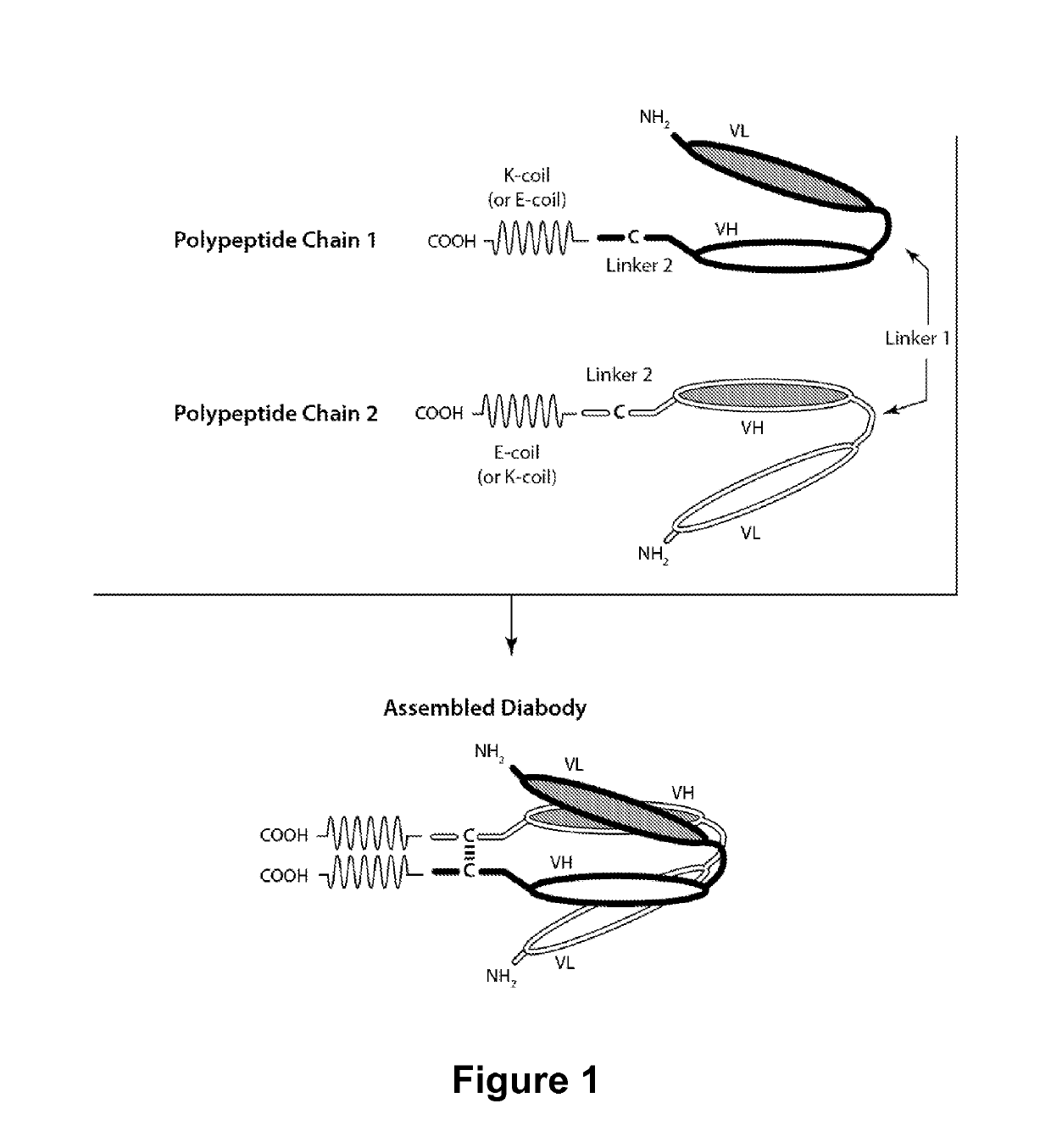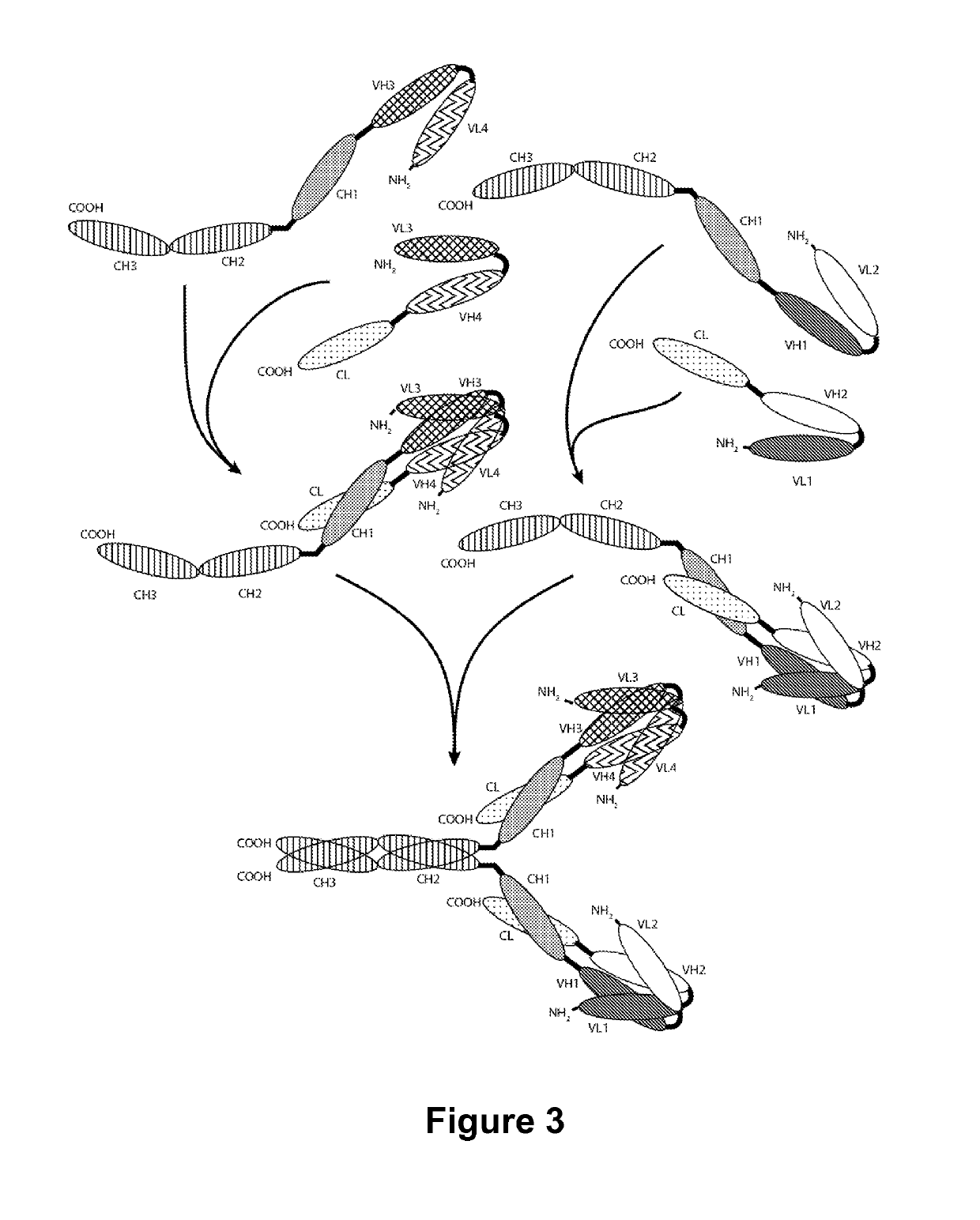Multivalent molecules comprising DR5-binding domains
- Summary
- Abstract
- Description
- Claims
- Application Information
AI Technical Summary
Benefits of technology
Problems solved by technology
Method used
Image
Examples
example 2
B. Species Specificity of Anti-Human DR5 Monoclonal Antibodies DR5 mAb 1 and DR5 mAb 2
[0605]In order to assess the species specificity of anti-human DR5 monoclonal antibodies DR5 mAb 1 and DR5 mAb 2, the ability of the antibodies to bind to human DR5 was compared with their ability to bind cynomolgus monkey (Macaca fascicularis) DR5. The results of this experiment are shown in FIG. 5. The results show that both antibodies are capable of binding to cynomolgus monkey DR5, but that they each exhibit higher binding affinity for human DR5.
[0606]The kinetics of binding was investigated using Biacore Analysis, as shown in FIG. 6. Bispecific DR5×CD3 diabodies were incubated with His-tagged DR5 and the kinetics of binding was determined via Biacore analysis. The diabodies employed were DR5 mAb 1×CD3 mAb 2 (FIG. 6, Panels A and E), DR5 mAb 2×CD3 mAb 2 (FIG. 6, Panels B and F), DR5 mAb 3×CD3 mAb 2 (FIG. 6, Panels C and G), and DR5 mAb 4×CD3 mAb 2 (FIG. 6, Panels D and H). FIG. 6, Panels A-D s...
example 8
H. Cytotoxicity of DR5 mAbs Alone, Cross-Linked or in Combination
[0625]The cytotoxicity of the DR5-Binding Molecules DR5 mAb 1 and DR5 mAb 2 of the present invention was examined in a number of cell lines using a non-radioactive cell proliferation assay. The activity of DR5 mAb 1 and DR5 mAb 2 alone, cross-linked, or in combination was examined.
[0626]Cell lines obtained from ATCC were cultured under standard tissue culture conditions. Each cell line was plated at ˜2×104 cells / well (in 96-well plates), and incubated overnight in F12 / DMEM media supplemented with 10% FBS. Separate wells (in triplicate) were treated with 0, or 1 μg / ml of DR5 mAb 1 or DR5 mAb 2±10 μg / ml goat anti-mouse IgG Fc antibody (designated “αmFc”) added one hour after the DR5 antibody to cross-link the DR5 mAbs, or with 1 μg / ml each DR5 mAb 1 and DR5 mAb 2 (total of 2 μg / ml anti-DR5 antibody) and incubated for two days. Cell viability was determined using Promega CellTiter 96® AQeous Non-Radioactive Cell Prolifer...
example 12
L. Cytotoxicity of Tetravalent DR5-Binding Molecules
[0644]The cytotoxicity of tetravalent DR5-Binding Molecules of the present invention was investigated. The activity of two exemplary bispecific tetravalent E-coil / K-coil-Fc Region-containing diabodies (DR5 mAb 1×DR5 mAb 2 Fc diabody; and DR5 mAb 2×DR5 mAb 1 Fc diabody), and four exemplary monospecific tetravalent E-coil / K-coil-Fc Region-containing diabodies (DR5 mAb 1×DR5 mAb 1 Fc diabody; DR5 mAb 1×DR5 mAb 1 Fc diabody (AA); DR5 mAb 2×DR5 mAb 2 Fc diabody; and DR5 mAb 2×DR5 mAb 2 Fc diabody (AA), where “AA” refers to the L234A / L235A mutation), on a number of cell lines was examined using the non-radioactive cell proliferation assay essentially as described above except that no cross-linking antibody was added to any of the test samples. His-tagged TRAIL (R&D systems) was used as a positive control.
[0645]Cell viability of cells treated with the test articles is normalized to the negative control (medium only) which is set to 100% ...
PUM
| Property | Measurement | Unit |
|---|---|---|
| Affinity | aaaaa | aaaaa |
Abstract
Description
Claims
Application Information
 Login to View More
Login to View More - R&D Engineer
- R&D Manager
- IP Professional
- Industry Leading Data Capabilities
- Powerful AI technology
- Patent DNA Extraction
Browse by: Latest US Patents, China's latest patents, Technical Efficacy Thesaurus, Application Domain, Technology Topic, Popular Technical Reports.
© 2024 PatSnap. All rights reserved.Legal|Privacy policy|Modern Slavery Act Transparency Statement|Sitemap|About US| Contact US: help@patsnap.com










